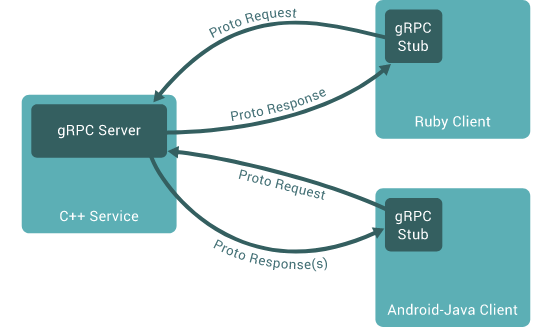gRPC Python tutorial
gRPC Python tutorial

Here is a comprehensive guide to getting started with gRPC Python:
Introduction
gRPC is an open-source framework for building scalable, high-performance APIs that can be used across various platforms, including mobile and web applications. It uses Protocol Buffers (protobuf) as the data serialization format, which ensures efficient and reliable communication between clients and servers.
Prerequisites

Before you begin with gRPC Python, make sure you have:
Python 3.5 or higher installed pip package manager installed (pip is the package installer for Python) A code editor of your choice (e.g., Visual Studio Code, PyCharm)
Step 1: Install gRPC and Protocol Buffers
Run the following command in your terminal/command prompt to install gRPC and Protocol Buffers:
pip install grpc protobuf
This will install both the gRPC library (grpc) and the Protocol Buffers compiler (protoc).
Step 2: Define Your Service Using Protocol Buffers
Create a new file called greeter.proto (or any other name you prefer) with the following content:
syntax = "proto3";
package greeter;
service Greeter {
rpc SayHello(HelloRequest) returns (HelloResponse) {}
}
message HelloRequest {
string name = 1;
}
message HelloResponse {
string message = 1;
}
This defines a Greeter service with a single method, SayHello, which takes a HelloRequest object and returns a HelloResponse object. The request contains a name field, while the response contains a message field.
Step 3: Generate Code for Your Service
Use the Protocol Buffers compiler (protoc) to generate code for your service:
protoc -I=. --python_out=. greeter.proto
This will generate a new file called greeter_pb2.py that contains the Python implementation of your service.
Step 4: Implement Your Service
Create a new file called greeter_server.py with the following content:
import grpc
from greeter_pb2 import Greeter
from greeter_pb2 import HelloRequest
from greeter_pb2 import HelloResponse
class GreeterServer(Greeter):
def SayHello(self, request: HelloRequest) -> HelloResponse:
return HelloResponse(message=f"Hello, {request.name}!")
def main():
server = grpc.server(futures.ThreadPoolExecutor(max_workers=10))
GreeterServer.add_to_server(server)
print("gRPC server listening on port 50051...")
server.add_insecure_port("[::]:50051")
server.start()
if name == "main":
main()
This implementation defines a GreeterServer class that implements the SayHello method. The main function sets up a gRPC server that listens on port 50051.
Step 5: Create a Client
Create a new file called greeter_client.py with the following content:
import grpc
from greeter_pb2 import Greeter
from greeter_pb2 import HelloRequest
from greeter_pb2 import HelloResponse
def main():
channel = grpc.insecure_channel('localhost:50051')
client = Greeter(channel)
request = HelloRequest(name='John')
response = client.SayHello(request)
print(response.message)
if name == "main":
main()
This implementation defines a main function that sets up a gRPC client that connects to the server on port 50051. It then sends a HelloRequest message and prints the response.
Conclusion
In this tutorial, you learned how to install gRPC and Protocol Buffers, define your service using protocol buffers, generate code for your service, implement your service, and create a client. This is just the beginning of your gRPC journey, but with these basics under your belt, you're ready to start building more complex APIs and applications!
Grpc python example github

I'm happy to help! Here's a detailed response:

If you're looking for a Python example of using gRPC, I've got some great news for you! You can find numerous examples on GitHub that demonstrate how to use gRPC in Python.
Firstly, let me give you an overview of what gRPC is. gRPC (gRPC Remote Procedure Call) is a high-performance RPC framework developed by Google. It allows you to create and manage remote procedure calls (RPCs) between clients and servers written in various programming languages. In the context of Python, you can use the grpc library to connect your Python applications with other services.
Now, let's dive into some examples!

Example 1: Basic gRPC Server
You can find a basic gRPC server example on GitHub by searching for "python-grpc-example". This example creates a simple RPC service that allows you to add two numbers. Here's the code:
import grpc
from . import helloworld_pb2
from . import helloworld_pb2_grpc
class Greeter(helloworld_pb2.Greeter):
def SayHello(self, request, context):
return helloworld_pb2.HelloReply(message='Hello, %s!' % request.name)
def main():
server = grpc.server(futures.ThreadPoolExecutor(max_workers=10))
helloworld_pb2_grpc.add_Greeter_to_server(Greeter(), server)
print('gRPC Server listening on port 50051...')
server.add_insecure_port('[::]:50051')
server.start()
server.wait_for_termination()
if name == 'main':
main()
Example 2: Client-Server Interaction
Here's another example that demonstrates client-server interaction using gRPC:
import grpc
class GreeterClient:
def init(self):
self.hello_request = helloworld_pb2.HelloRequest(name='Alice')
def greet(self, target):
channel = grpc.insecure_channel(target + ':50051')
stub = helloworld_pb2_grpc.GreeterStub(channel)
response = stub.SayHello(self.hello_request)
print('Got reply from %s: "%s"' % (target, response.message))
if name == 'main':
client = GreeterClient()
targets = ['localhost', 'other-machine']
for target in targets:
client.greet(target)
In this example, the client connects to multiple servers and sends a greeting request. The server responds with a message.
Example 3: Advanced gRPC Features
The grpc library also supports advanced features like streaming, bidirectional streaming, and client-side streaming. These features are perfect for applications that require efficient data transfer.
For instance, you can use the ClientStreamingCall class to send multiple requests at once:
import grpc
class StreamRequest:
def init(self):
self.requests = []
def add_request(self, request):
self.requests.append(request)
def start_streaming(self):
channel = grpc.insecure_channel('localhost:50051')
stub = helloworld_pb2_grpc.GreeterStub(channel)
response = stub.ClientStreamingCall(self.start_streaming())
for request in self.requests:
stub.AddNumbers(request, response)
if name == 'main':
client = StreamRequest()
Add multiple requests
client.add_request(helloworld_pb2.AddTwoNumbersRequest(a=1, b=2))
client.add_request(helloworld_pb2.AddTwoNumbersRequest(a=3, b=4))
client.start_streaming()
These are just a few examples of using gRPC in Python. For more information and code snippets, feel free to explore GitHub or the official gRPC documentation!
I hope this helps!





























